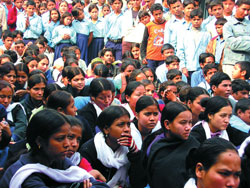|
|
Nepal has one natural resource in abundance that isn't related to water. One that doesn't require a foreign consortium to descend from on high and exchange up-front cash for long-term ownership. This is a commodity that has long since disappeared from the developed world, and though many others beyond America and Europe possess it, there is inexhaustible demand that isn't related to supply.
The resource is youth. Nepal is one of the youngest countries in the world, with more than half its population under thirty. That means energy, dynamism, and opportunity galore for almost everyone here, young and old alike. By contrast, France, Britain, and other European countries have discovered one of the great truisms of development-affluence is the only truly effective form of birth control. America and Canada would be equally aged if it weren't for immigration. In both of North America's rich giants, only the newly-arrived are swelling the ranks of the young.
Childless marriages just hit a new all-time high in the United States. More people are living their entire lives as singles, never getting married or having kids.
Universities are jam-packed, but that's a combination of a demographic bulge about to steeply decline, and foreign students hungry for a decent education. The rich world is aging fast, and places like Nepal are chock-a-block with youth.
I look around Canada, where I bide my time at the moment. What do I see? Old, white people and young brown, black, and Asian people. The new demography of North America. Rich, settled, aging whites who aren't reproducing, and plenty of the world's children from elsewhere coming in to make up for that. Not that all the young incomers aren't white. Some are from Eastern Europe and many are Latinos of varying hues, but they are mostly poor, or at least lacking in much that the native-born of rich countries take for granted.
I am confident this represents the cusp of amazing change. Some see the flow of people outward from Asia to America or Europe as brain drain and, to a certain extent, it has been. Nepali doctors and academics should be labouring in Nepal, but who can fault them for fleeing war, political stasis, and ludicrous misrule by kings and politicians alike? What's more intriguing than the flight of the elite from places like Nepal is the status of the others who emigrate, who seek DV visas, or slip abroad with the help of people smugglers.
Many are not especially well-off, but plenty are at least middle class and literate, by the standards of home. They go to Toronto, New York, or London to work as plumbers, waiters, nurses, and office workers. In each of these places, shortages of skilled and semi-skilled labour have cost local economies dearly in recent years.
Countries like Canada now court construction workers in overseas jobs fairs, and try to lure welders and pipefitters from China to South Africa. The native-born, it seems, just won't do those jobs. Or they're too old.
The biggest growth area in the job markets of North America and Europe doesn't involve a box of tools or years of post-secondary education. In the coming years, the single, the childless, and the otherwise unsupported elderly of the rich world will need care. And they'll be paying for it. They'll have money but no caregivers to spend it on. More and more Nepalis, Sri Lankans, Thais, and Brazilians are answering that particular call. Courses to help the elderly are oversubscribed.
So, yes, Nepal needs many things at the moment. But of pressing concern is a strategy on its most important natural resource-how to keep the young people here. Before they all leave to high-paying jobs looking after the likes of me in Canada. I pay well, mind.




